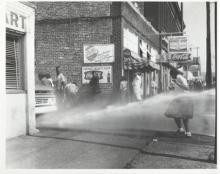nonviolent protests

BIRMINGHAM, Ala. — In May 1963, thousands of Birmingham school children faced police dogs, fire hoses, and possible arrest to demonstrate against segregation. Now, 50 years later, those who were part of what became known as the “Children’s March” say they don’t want their story to be forgotten.
“We were doing this not just for ourselves but for some higher purpose,” said one of the young marchers, Freeman Hrabowski III. “It focused on civil rights for all Americans.”
Hrabowski is now president of the University of Maryland, Baltimore County. He was 12 when he marched in Birmingham and was arrested for parading without a permit. He and hundreds of other children were held in custody for five days before being released.
Experts say the children’s crusade helped galvanize the civil rights struggle at a time when efforts were flagging.
“That was really the tipping point in a tipping year,” Pulitzer Prize-winning author Taylor Branch, who has written a series of books about the civil rights movement, told the PBS program “Religion & Ethics NewsWeekly.”
Watch Birmingham and the Children’s March on PBS. See more from Religion & Ethics NewsWeekly.
Occupy Wall Street's struggle for nonviolence. What do marriage and family have to do with economic growth? Map: Protesters' long-term plans for occupying Zuccotti Park. Herman Cain to meet with Arizona sheriff Joe Arpaio over immigration. While corporate profits are at 60-year high, main street businesses continue to struggle.
I love words. They nourish me more than food. As a child (and even now, as an adult) I read novel after novel, losing myself in the characters, the plot, and the effortless descriptions of good writers. If I could swallow the New York Times, I would. (There are also many other fantastic newspaper publications out there; I'm not partial.) The discovery of Google reader has been my biggest internet distraction to date. A picture may be worth a thousand words, but I'd rather the thousand words.
Last Friday, at a protest against the Israeli separation barrier in the West Bank town of Bil'in, Palestinian nonviolent activist Jawaher Abu Rahmah was killed by http://www.google.com/url?q=http%3A%2F%2Fmondoweiss.net%2F2011%2F01%2Fde...
On Feb. 1, 1960, four African-American students sat down at the "whites-only" lunch counter at the F.W. Woolworth store in Greensboro, North Carolina. As I child, I was told by my late father that he took his youth group to participate in these sit-ins.